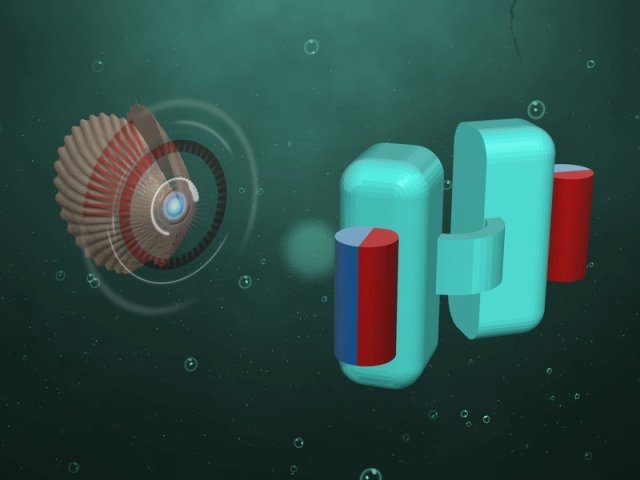 Planck researchers in Stuttgart has built a tiny submarine, shown in the drawing on the right. Small magnets, shown here as red and blue cylinders, open and close the two halves (shells) of the device. © Photo: Alejandro Posada / MPI for Intelligent Systems
Planck researchers in Stuttgart has built a tiny submarine, shown in the drawing on the right. Small magnets, shown here as red and blue cylinders, open and close the two halves (shells) of the device. © Photo: Alejandro Posada / MPI for Intelligent Systems
Researchers at the Max Planck Institute for Intelligent Systems have developed nanoscale swimming bodies which are able to navigate through complicated biological fluids.
This new breakthrough could facilitate precise drug delivery to target sites and may even allow gene therapy to be performed in a particular cell. Complex surgical procedures can be possibly prevented or certain procedures can be made minimally invasive using this new technology.
The research team, in collaboration with Technion and Technical University researchers, developed an artificial microscopic scallop which travels through liquids by closing and opening its shell, which is just a few times thicker than a human hair. The device was tested in model fluids which have completely different characteristics to water.
The viscosity in most bodily fluids changes based on the speed of movement. For instance, the synovial fluid in joints have a network of hyaluronic acid molecules which result in a high viscosity. This becomes less viscous when something moves within this fluid.
By making use of this fluid property, the researchers designed the scallop in such a way that it opens faster than it closes. This irregular pattern of movement makes the fluid less viscous during opening when compared to the time of subsequent closing.
As a result, the distance travelled by the scallop during the opening stroke is not the same as the distance it moves backward during the closing stroke, thus resulting in net forward propulsion.
In order to control the micro-devices, small rare-earth magnets were integrated into the two scallop shells. This approach enabled the researchers to control the opening and closing of the scallop shells and thus the movement of the devices.
A tiny scallop-shaped submarine can also be propelled by an actuator which responds to changes in temperature. The challenge was to design shells which are thin, yet strong enough to remain stable in viscous liquids.
The team attempted to test their tiny devices in biological fluids such as in the extracellular matrix of a tissue. In order to perform such tests, an even smaller device resembling a corkscrew-shaped nanohelix was designed. The researchers developed a propeller which measured 100nm in diameter, with the overall the device measuring just 400nm in length.
The team then deposited the helix material layer by layer in order to create a geometrically-defined pattern and integrated magnetic nickel at strategic locations. Upon the application of a rotating magnetic field, the nickel-containing nano-screw began to rotate and allowed the propeller to move in a forward direction through a liquid.
Theoretically, given the size of our device, it could conceivably also be used within cells.
Peer Fischer, leader of the Micro, Nano and Molecular Systems Research Group at the Max Planck Institute for Intelligent Systems
The researchers believe that nano-submarines have potential applications within the field of medicine. This research has been published in Nature Communications and the ACS Nano scientific journal.